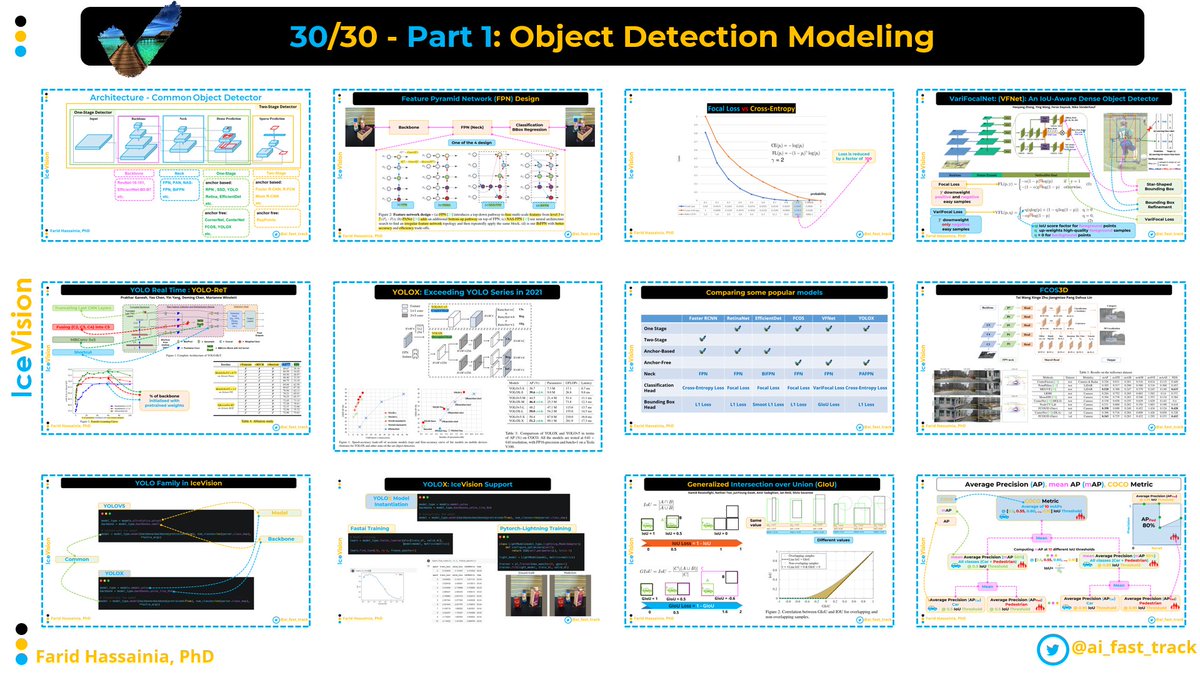
I’m at Day 23 of my 30 posts (on Object Detection) in 30 days challenge
I gathered 12 visual summaries on OD Modeling 🎁
A lot of people find those posts helpful, follow @ai_fast_track to catch the upcoming posts, and give this tweet a quick retweet 🙏
Summary of summaries👇
I gathered 12 visual summaries on OD Modeling 🎁
A lot of people find those posts helpful, follow @ai_fast_track to catch the upcoming posts, and give this tweet a quick retweet 🙏
Summary of summaries👇

1- Common Object Detector Architecture you should be familiar with:
https://twitter.com/ai_fast_track/status/1453368771285032971
2- Four Feature Pyramid Network (FPN) Designs you should know:
https://twitter.com/ai_fast_track/status/1460297658472574982
3- Seven things you should know about the Focal Loss
https://twitter.com/ai_fast_track/status/1452672706986582016
4- FCOS is the first anchor-free object detector that beat two-stage detectors
https://twitter.com/ai_fast_track/status/1462198412489760774
6- How easy creating YOLOV5 and YOLOX models in IceVision
https://twitter.com/ai_fast_track/status/1455916305333301252
7- VFNet: A very interesting model that isn’t under the radar
https://twitter.com/ai_fast_track/status/1461042489545134089
8- YOLO Real-Time (YOLO-ReT) architecture targets edge devices.
It achieves 68.75 mAP on Pascal VOC and 34.91 mAP on COCO
It achieves 68.75 mAP on Pascal VOC and 34.91 mAP on COCO
https://twitter.com/ai_fast_track/status/1455585130446270471
9- Similarities and the differences between some popular Object Detection models.
https://twitter.com/ai_fast_track/status/1459258545174552576
10- FCOS3D won the 1st place out of all the vision-only methods in the nuScenes 3D Detection Challenge of NeurIPS 2020.
https://twitter.com/ai_fast_track/status/1456312747499704320
11- The Generalized Intersection over Union (GIoU) can be used as a metric as well as a loss function
https://twitter.com/ai_fast_track/status/1458923734346129408
12- What is the Average Precision (AP), mean AP (mAP), and COCO Metric?
https://twitter.com/ai_fast_track/status/1458100264297189381
⭐️ If you find those summaries helpful, feel free to follow @ai_fast_track for more OD / CV demystified content in your feed
⭐️ If you could give the thread a quick retweet, it would help others discover this content. Thanks!
⭐️ If you could give the thread a quick retweet, it would help others discover this content. Thanks!
https://twitter.com/ai_fast_track/status/1463177309381402634
• • •
Missing some Tweet in this thread? You can try to
force a refresh








